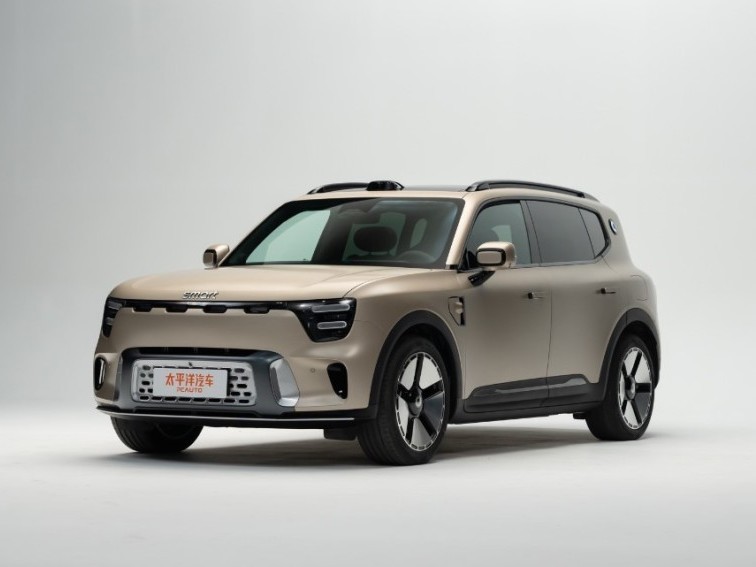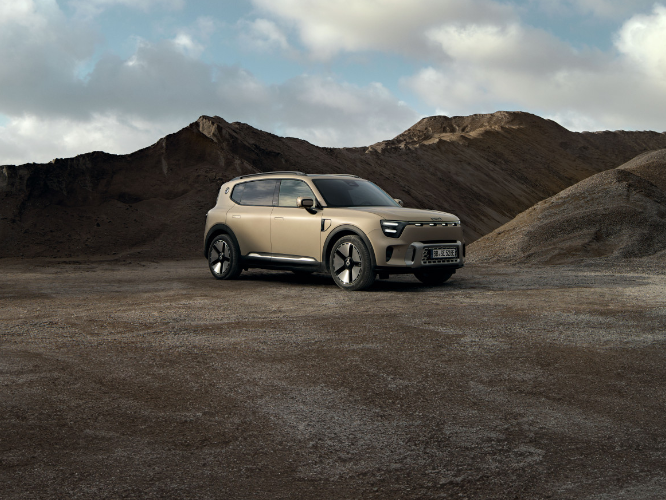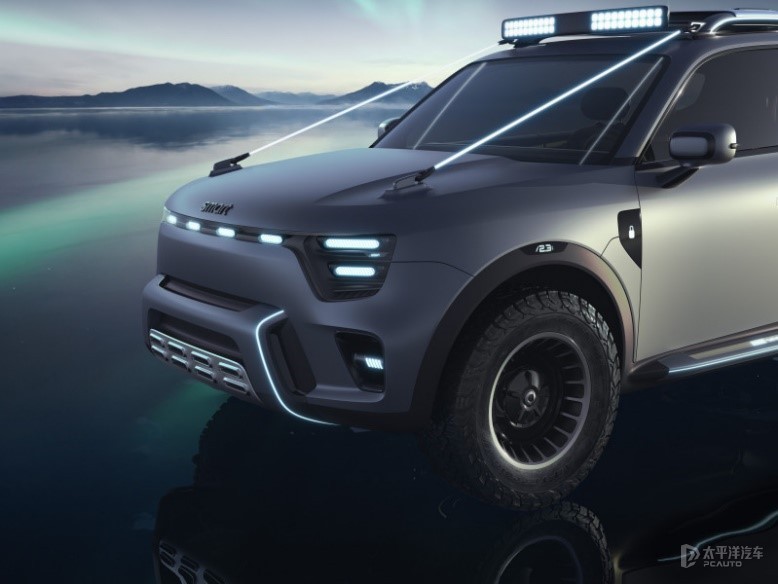Q
What is the spec of Smart #1 in Malaysia?
The Smart #1 is available in three versions in Malaysia: Pro, Premium, and BRABUS. It's a Class B all - electric SUV, measuring 4,270mm in length, 1,822mm in width, and 1,636mm in height, with a wheelbase of 2,750mm. It has 5 doors and 5 seats, and the trunk volume is 411L.
In terms of power, the Pro and Premium versions are equipped with a rear - mounted single motor, with a maximum power of 200kW, a maximum torque of 343N·m, an acceleration from 0 - 100km/h in 6.7 seconds, and a top speed of 180km/h. The BRABUS version comes with dual motors (front and rear), with a combined power of 315kW, a total torque of 543N·m, and a maximum horsepower of 428PS.
Regarding the range, the official all - electric range of the Pro version is 315km, and its battery capacity is 49kWh. The Premium version has a range of 440km, and the BRABUS version has a range of 400km. Both the Premium and BRABUS versions have a battery capacity of 66kWh, and the battery comes with a 4 - year warranty.
In terms of configuration, all three versions are equipped with numerous safety and comfort features, such as 7 airbags, body stability control, and a 360 - degree parking camera. Inside the car, the driver's seat in the front row is electrically adjustable, and the passenger seat and the rear seats are in a 60:40 ratio. There is an automatic air - conditioning system in the front row and air vents in the rear. In addition, there are LED headlights, automatic headlights, and rain - sensing wipers.
There are differences in price among different versions. The Pro version is priced at RM 169,000, the Premium version at RM 209,000, and the BRABUS version at RM 249,000.
Special Disclaimer: This content is published by users and does not represent the views or position of PCauto.
Related Q&A
Q
How big is Smart #1?
The Smart #1 is a compact all-electric SUV with a body measuring 4,270 mm in length, 1,822 mm in width, and 1,636 mm in height, along with a wheelbase of 2,750 mm. This size makes it extremely nimble on the urban roads of Malaysia while also offering a decent amount of interior space. Its design combines style and practicality, making it a great fit for young families or urban commuters. The trunk has a capacity of approximately 411 liters, which can be expanded further when the rear seats are folded down to meet the needs of daily shopping or short trips.
As an electric vehicle, the Smart #1 has been performing outstandingly in the Malaysian market. It offers high charging convenience and has sufficient range for daily use. Coupled with its compact body, it's perfect for navigating through busy cities like Kuala Lumpur. Moreover, its intelligent features and driving assistance systems enhance driving safety and convenience. It's an option that combines environmental friendliness and practicality.
Q
How much horsepower does the Smart #1 have?
As a pure - electric SUV, the Smart #1 offers two powertrain versions in the Malaysian market. Among them, the high - performance BRABUS version has a maximum power of 428 horsepower, and it can accelerate from 0 - 100km/h in just 3.9 seconds. The regular rear - wheel - drive version has 272 horsepower, which meets the needs of daily driving. This vehicle is built on Geely's SEA vast platform and is equipped with a 66kWh ternary lithium battery pack. It has a WLTP range of up to 440 kilometers and supports 150kW fast charging. It can charge the battery from 10% to 80% in 30 minutes.
For Malaysian consumers, the intelligent features of the Smart #1 are also quite appealing, including a 12.8 - inch central control screen, an intelligent driving assistance system, and exclusive mobile app control functions. It's worth mentioning that electric vehicles in Malaysia enjoy exemptions from import duties and consumption taxes, which makes electric models like the Smart #1 more price - competitive. Meanwhile, the Malaysian government is actively expanding the charging infrastructure, and the usage environment for electric vehicles will be more convenient in the future.
Users with different driving needs can choose the appropriate version according to their own circumstances. The high - performance version is suitable for users who pursue driving pleasure, while the rear - wheel - drive version is more suitable for urban commuting.
Q
Is Smart #1 electric?
Yes, the Smart #1 is a pure-electric vehicle jointly developed by the Smart brand and Geely Auto. Built on Geely's SEA pure-electric platform, it's specifically designed for urban driving, making it an excellent fit for bustling Malaysian cities like Kuala Lumpur and Penang.
The Smart #1 comes with either a rear-mounted single motor or a dual-motor all-wheel-drive version. It can achieve a range of up to 440 kilometers (WLTP standard) and supports fast charging. It only takes about 30 minutes to charge the battery from 10% to 80%, eliminating the concerns of electric vehicle users about range and charging time.
This car is also equipped with advanced intelligent driving assistance systems such as adaptive cruise control and automatic parking, enhancing driving convenience and safety. For Malaysian consumers, apart from the environmental benefits of electric vehicles, they can also enjoy government incentives like tax breaks. The compact size and nimble handling of the Smart #1 are particularly suitable for the narrow streets and limited parking spaces in Malaysia.
Moreover, as the charging infrastructure in Malaysia continues to improve, the experience of using electric vehicles will be further enhanced. Models like the Smart #1 are expected to become the ideal choice for urban commuting.
Q
How many kWh to charge a Smart #1?
As a pure-electric SUV, the Smart #1 has a battery capacity of 66 kWh (for the NMC ternary lithium battery version). Considering the actual charging efficiency and losses, it usually takes about 70 - 75 kWh of electricity to charge the battery from 0% to 100%. The specific value may vary slightly depending on the charging environment temperature, battery status, and the power of the charging pile. In Malaysia, it takes about 6 - 7 hours to fully charge the vehicle using a common 11 kW AC charging pile. However, if using a 150 kW DC fast charger, it can charge the battery from 10% to 80% in 30 minutes, which is more suitable for long - distance travel needs.
For electric vehicle users, understanding charging efficiency and battery management is equally important. The Smart #1 is equipped with a heat pump air - conditioner and an intelligent temperature control system, which can optimize energy consumption and extend battery life. In Malaysia's hot climate, it is recommended to choose shaded charging or night - time charging to reduce the impact of high temperatures on the battery.
In addition, the Malaysian government is accelerating the expansion of public charging facilities. Users can find charging stations through local operators such as ChargeSini or JomCharge. Reasonably planning trips can further enhance the convenience of using electric vehicles.
Q
How to reset smart #1?
To reset the smart #1, you can usually do it through the "Restore Factory Settings" option in the vehicle's infotainment system or the dashboard menu. The specific steps may vary depending on the model year and configuration. It is recommended to refer to the owner's manual or contact the authorized smart service center in Malaysia for accurate guidance. As an electric vehicle, the system reset of the smart #1 may involve the initialization of in - vehicle software, driving modes, or charging settings. Make sure the vehicle is parked and the battery is fully charged when performing the operation.
In Malaysia, local dealers provide technical support for smart models. If you encounter complex issues such as the system fault light coming on or abnormal performance, it is advisable to schedule a professional inspection promptly to avoid any improper operations that could affect the vehicle's warranty. Additionally, regularly updating the in - vehicle software can enhance the user experience. After some functions are reset, you may need to log in to your account again or configure your personal preferences. Familiarizing yourself with these operations will allow you to drive this stylish electric car more efficiently.
Q
What is the first service of Smart #1?
It is recommended that the first maintenance of the Smart #1 be carried out when the vehicle has traveled 10,000 kilometers or after 12 months (whichever comes first). This mainly includes basic items such as battery system checks, high - voltage component status inspections, tire and braking system checks, and in - vehicle software updates to ensure the normal operation of the core components of the electric vehicle. For Malaysian car owners, since the tropical climate may accelerate the wear and tear of the battery cooling system, it is advisable to pay extra attention to the coolant status and the efficiency of the air - conditioning system.
The maintenance intervals of electric vehicles are generally longer than those of fuel - powered vehicles, but regular inspections are still crucial. For example, the sealing of high - voltage wiring harnesses needs to be well - protected in high - temperature and high - humidity environments. If you often drive on rainy roads, you can check the chassis waterproof performance in advance, which is different from the maintenance logic of fuel - powered vehicles.
The maintenance of the Smart #1 can be completed through authorized service centers. Malaysian users can also use the APP to book the door - to - door pick - up and delivery service, which saves time. The maintenance cost of electric vehicles is usually lower than that of fuel - powered vehicles because there is no need to change the engine oil or spark plugs. However, monitoring the battery health is the key to long - term vehicle use. It is recommended to conduct a in - depth diagnosis every 20,000 kilometers.
Q
Does Smart #1 have ventilated seats?
As an electric vehicle targeting young consumers, the Smart #1 indeed offers ventilated seats in the Malaysian market. However, it's important to note that this configuration usually comes with high - end versions or optional packages. It is recommended that consumers confirm the configuration list of specific models with local dealers before purchasing. The ventilated seat function promotes air circulation through built - in fans, which is especially suitable for the hot and humid climate in Malaysia and can effectively enhance the comfort of long - distance driving. Meanwhile, the vehicle is also equipped with a seat heating function, taking into account different usage scenarios. Some versions of electric vehicles in the same class, such as the Tesla Model Y or the BYD Atto 3, also offer similar configurations, but the implementation methods may vary. Some use a suction - type design to reduce noise. As a product of the cooperation between Geely and Mercedes - Benz, the seat system of the Smart #1 inherits the emphasis on ergonomics of European cars. In addition to the ventilation function, it usually also has multi - way electric adjustment and memory functions. These detailed designs are worthy of the attention of Malaysian consumers with sufficient budgets. After all, in a high - temperature environment, seat comfort can significantly affect the driving experience.
Q
What is the real-world range of the Smart #1?
As a pure-electric SUV, the actual range of the Smart #1 varies depending on factors such as driving conditions, road conditions, and climate. Official data shows that its WLTP range is approximately 440 kilometers. However, in actual use in Malaysia, due to the high temperature and frequent use of air conditioning, the range may slightly decrease to around 400 kilometers. This performance is sufficient for daily commuting and urban driving.
The Smart #1 is equipped with an efficient electric drive system and advanced battery management technology, which can optimize energy consumption. It also supports fast charging, allowing a large amount of electricity to be replenished in a short time, making it very suitable for the urban driving environment in Malaysia.
For Malaysian consumers considering electric vehicles, besides the range, they can also focus on the convenience of charging facilities. The charging network in Malaysia is expanding rapidly, and there are more and more charging stations in major cities and along highways, making the use of electric vehicles more convenient.
In addition, the low maintenance cost and environmental - friendly features of electric vehicles are also advantages worth considering. Especially against the backdrop of the Malaysian government's promotion of green travel policies, choosing an electric vehicle can not only save fuel costs but also reduce carbon emissions, being more friendly to the environment.
Q
What plug type is smart #1?
As a pure-electric SUV, the smart #1 uses a Type 2 (Mennekes) charging port in the Malaysian market. This is the mainstream AC charging standard in Europe and Malaysia, which is compatible with most local public charging piles and home wall-mounted chargers. At the same time, it supports the CCS2 (Combined Charging System) DC fast-charging port, which can meet the need for quick recharging. The charging infrastructure in Malaysia is gradually improving, and Type 2 and CCS2 have become the mainstream configurations. Users can easily find suitable charging stations through local charging networks such as MYEV or ChargeSini. For home charging, it is recommended to install a wall-mounted charging box with a power of over 7kW to optimize the charging efficiency. Also, note that the voltage in Malaysia is 240V single-phase electricity, which meets the charging requirements of Type 2. If you need to travel long distances, you can plan in advance to use DC fast-charging stations with a power of over 50kW along the way. Usually, it only takes 30 minutes to charge the vehicle to 80% of its capacity. There may be compatibility differences among charging piles of different brands. It is recommended to use the charging service providers recommended by the original manufacturer to ensure stability.
Q
How big is the boot on the Smart #1?
As a compact all-electric SUV, the Smart #1 comes with a trunk capacity of 411 liters (VDA standard), which is more than enough to meet the needs of daily shopping or short trips. When the rear seats are folded down, the space can be expanded to 986 liters, offering great flexibility and catering to the occasional need of Malaysian users to transport large items. It's worth mentioning that an electric tailgate comes as standard across all models, enhancing the convenience of use.
In the realm of electric vehicles in the same class, the trunk space of the Smart #1 ranks above average. For example, it's more practical than the Volvo EX30, which has a standard capacity of only 318 liters. In Malaysia's hot and rainy climate, the well - organized layout and anti - slip materials in the Smart #1's trunk are also commendable, making it convenient to place wet rain gear or easily rolling items.
Although the battery pack of an electric vehicle usually takes up some under - chassis space, the Smart #1 still maintains good loading capacity through clever design. This is a plus for Malaysian family users who value practicality.
Latest Q&A
Q
How big is Myvi fuel tank?
As one of the most popular national cars in Malaysia, the fuel tank capacity of the Perodua Myvi varies according to different generations and versions. The standard fuel tank capacity of the current third - generation Myvi (from 2017 to present) is 36 liters. It features a lightweight resin fuel tank design, which balances the fuel storage needs and the vehicle's body weight.
The fuel tank size of this B - segment model matches the fuel economy of its 1.3L/1.5L engines. It can provide a cruising range of approximately 450 - 550 kilometers under combined driving conditions, making it suitable for urban commuting and short - distance trips. It's worth noting that the actual available fuel tank capacity might be slightly less than the nominal value. This is because about 5% of the tank space is reserved for fuel expansion as a safety measure.
For owners planning long - distance drives, it is recommended to use the fuel efficiency display function on the Myvi's dashboard to monitor fuel consumption in real - time. Also, it's advisable to develop the habit of refueling when the fuel gauge shows that there is about 1/4 of the fuel left. This can prevent the fuel pump from overheating and also help deal with the situation where gas stations are far apart in some remote areas of Malaysia.
Some comparable models in the same segment, like the Proton Iriz, have a 40 - liter fuel tank. However, the actual cruising range needs to be considered in combination with the engine efficiency. Thanks to Perodua's mature powertrain tuning, the Myvi always maintains a competitive edge in terms of fuel economy.
Q
Does Myvi use CVT?
Yes, the Perodua Myvi does use CVT (Continuously Variable Transmission) technology in some models, especially the newer ones. For instance, the third-generation Myvi, launched in 2017, and its subsequent versions are equipped with D-CVT (Dual Mode Continuously Variable Transmission) to offer a smoother driving experience and better fuel efficiency. CVT technology optimizes engine performance through continuously variable gear ratios. Compared with traditional automatic transmissions, it can adapt to driving conditions more flexibly, thereby enhancing overall driving comfort. However, earlier Myvi models may have used a traditional 4-speed automatic transmission. So, whether a specific model is equipped with a CVT needs to be confirmed based on the model year and configuration. For Malaysian consumers, the advantages of CVT lie in its smoothness and fuel - saving performance during city driving, which is very suitable for the common local traffic conditions. But if you're looking for more direct power feedback, some drivers may prefer the manual transmission version. If you're considering buying a Myvi, it's recommended to check the official specifications or consult a dealer to confirm the transmission type. You can also take a test drive to see if the actual performance of the CVT meets your driving preferences.
Q
What kind of gearbox is Myvi?
The Myvi is equipped with a Dual Mode CVT (D-CVT) transmission, which is a dual-mode continuously variable transmission. Compared with traditional CVT transmissions, it has an additional gear for high-speed driving, which helps the vehicle achieve better fuel efficiency.
In daily driving, this transmission drives the vehicle in CVT mode. Thanks to the operation of the steel belt, the vehicle moves smoothly and linearly, enhancing comfort. What makes the D-CVT special is that it automatically switches to the gear mode when driving at high speeds. Different from CVT transmissions of other brands, when driving at high speeds, the engine speed of vehicles with ordinary CVT transmissions will increase, the engine noise will get louder, and the fuel consumption will rise. Moreover, the power will decline after exceeding the maximum horsepower speed. However, after the gear of the D-CVT engages, the engine speed decreases, allowing the engine to maintain a reasonable speed and providing the vehicle with continuous and abundant power.
Q
Are Myvi and vios the same engine?
Some models of the Myvi and the Vios use the same engine. Daihatsu and Perodua have a joint - venture engine production plant in Negeri Sembilan, Malaysia, which provides power for multiple models including the Vios. Some models of the Vios and the Myvi are equipped with the 1.5L Dual VVT - i engine. This engine features high efficiency, reliability, and economy. Although its power is not extremely strong (the official 0 - 100km/h acceleration time of the Myvi 1.5 is 10.2 seconds), its low fuel consumption and durability are well - loved by consumers. However, these two cars have different positioning and market targets. Even if they share the engine platform, there are differences in vehicle tuning, configuration, and the overall driving experience.
Q
How many cylinders are in the MYVI?
As one of the most popular national cars in Malaysia, the engine configurations of the Perodua Myvi vary according to different years and versions. Currently, the mainstream models are equipped with two types of Dual VVT - i four - cylinder naturally aspirated engines, namely the 1.3L (1NR - VE) and 1.5L (2NR - VE). Therefore, all Myvi models feature a four - cylinder design. This four - cylinder layout ensures smooth power delivery while taking fuel economy into account, making it highly suitable for the urban road conditions in Malaysia.
It's worth mentioning that four - cylinder engines, due to their simple structure and low maintenance costs, are widely used in B - segment models in the local market. For example, the Proton Saga and Honda City also adopt a similar layout. The 1.5L version of the Myvi can output 102 horsepower and 136 Nm of torque. Coupled with its lightweight body design, it can offer a well - balanced performance whether driving on the congested streets of Kuala Lumpur or cruising on the highway.
For readers who want to learn about engine technology, they can note that the Dual VVT - i system used in the Myvi can intelligently adjust the valve timing. This technology shared by Toyota helps to improve fuel efficiency by about 15%. That's why the Myvi has remained one of the most fuel - efficient cars in Malaysia for years.
View MoreRelated News

Smart #5 is expected to go on sale on October 27, with a range of over 700km, and may be introduced!
Kevin WongOct 22, 2024

The biggest smart in history, the brand-new smart elf #5 is now open for pre-order
AshleySep 23, 2024

smart#5 Explains: Mercedes-Benz Design, with a Range of Up to 740km!
Kevin WongSep 4, 2024

Smart #5 global debut: 800V high voltage platform + dual motor four-wheel drive
LienAug 28, 2024

mart#5: Say goodbye to small size and enter a new era of large size, launching globally on August 28th
AshleyJul 25, 2024
View More













 Cars
Cars




Pros
Cons